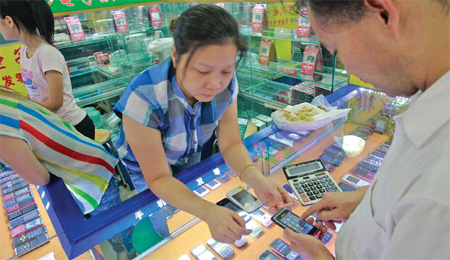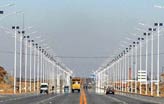Cell phone capital of the world
Updated: 2011-09-16 08:42
By Alexis Hooi (China Daily)
|
|||||||||
|
|
Coastal city within China's economic powerhouse takes lead in global mobile phone industry
On North Huaqiang Road in Shenzhen, Guangdong province, Zhao Shiyong taps the screen of his latest mobile phone and boasts its features to the young man in front of him. "It's got all the applications you need and more games than you can ever play," says Zhao, whose hometown is in neighboring Hunan province. "And I can offer it to you at a fraction of the price you would most probably find in the bigger stores."
| ||||
Shenzhen, as a manufacturing hub fueled by overseas investment including those from the neighboring Hong Kong, has helped tap the rich resources of the Pearl River Delta to make the region one of the engines of the Chinese economy since late 1970s. Major industries now include high-tech manufacturing and IT as well as financial services and logistics.
But it is the mobile phone sector that is putting the city on the world map, Shenzhen Mobile Communications Association Secretary-General Sun Wenping says.
"There are 1 billion mobile phone units coming out of Shenzhen and its immediate surroundings every year. That is out of the estimated 1.7 billion to 1.8 billion units worldwide annually," Sun says. His three-year-old nongovernmental association, which has 1,100 members, also helps authorities tabulate industry figures and conduct studies on the sector as a whole.
"There is a growing need to understand the industry because of the speed with which it is growing and its increasing importance to the economy," Sun says.
Latest figures from the Ministry of Industry and Information Technology show that China's mobile phone operators added 70.83 million new subscribers in the first seven months of this year, bringing the country's total number of cell phone users to 929.84 million out of the 4 billion worldwide.
Shenzhen alone has about 6,000 companies involved in the production of cell phones, including supporting businesses like suppliers of batteries, chargers and other accessories. There are about 3,000 complete cell phone manufacturers of which the top 50 rake in about 5 billion yuan ($782 million) every year, association figures show.
It is an industry that was already worth 370 billion yuan last year and employs about 1 million people in the area, Sun says.
Chen Yongbin, a director of Shenzhen-based company Haoxing Co, says he is just a small player aiming for a piece of the city's cell phone pie.
Chen's company employs less than 60 people and rakes in less than 15 million yuan a year from the cell phone accessories it provides to major players, which then export their phones to buyers in Asia and the Middle East.
"My business is completely aimed at the overseas market," says Chen, 42. "Here in Shenzhen, the cell phone supply chain is better, faster and more complete than anywhere else in the world."
Shenzhen is a major exporter of mobile phones, association secretary-general Sun says. Domestic demand for the handsets is about 300 million to 400 million units a year, so what remains of the 1.1 billion units produced in Shenzhen are then exported to major destinations like India.
The city's lead in the cell phone industry is due to various factors that evolved in the past two decades but saw a significant surge in the mid-2000s.
A turning point was when Taiwan-based MediaTek Inc introduced new technology that significantly lowered costs for the already low-end mobile phone makers, Sun says.
Analysts say there are generally three major categories for mobile phones made in China. The first category is made up of handsets from Chinese suppliers of global brands or original design manufacturers. The second group comes from Chinese companies or original equipment manufacturer partners, which make Chinese brands. The third category is made up of mobile phones that do not belong to any brand. These are the thousands of "nameless" manufacturers that roll out products including the infamous "shanzhai" or "copycat" handsets.
Huaqiang Bei Road itself was once famous for selling shanzhai phones before becoming one of the largest distribution centers for mobile handsets that it is today.
But Sun says it can be difficult to pin down what shanzhai phones really mean and whether all of them are illegal "copies".
"What is shanzhai? How do you accurately define it? There are so many kinds of handsets being made here and the distinctions can often blur," Sun says.
"It also has to do with the amazing speed of the industry. Making a cell phone from scratch - from coming up with the idea to bringing it to market - takes just 25 days in Shenzhen. That makes it very tough to categorize the range of products under the law and regulations, which can have a problem keeping up with the development of the industry," he says.
"The main consideration for businesses, of course, is that their actions must be legal and not harmful to customers and society."
For now, the increasing speed and size of the industry are virtually unstoppable, he says.
"Cell phones have become an indispensable part of modern life. It is borderless in the sense that it does not have to adhere to specific cultures like clothes, or other similar items like chopsticks which are predominantly used in Asian countries," Sun says.
The rate of mobile phone usage is also just 40 percent in China's rural areas and that figure is less, only 30 percent, in less developed countries, Sun says.
In China, each cell phone user replaces a handset once every year on average. That is compared with once every one and a half years for users in North America and Europe, he says.
"We are the fastest in Shenzhen. We change our handsets at least once in less than a year," Sun says.
The increasing use of mobile phones among the elderly and young also mean the industry has got a lot of room to grow, he says.
"And then we have the benefit and promise of technology," Sun says.
"There are all kinds of phones now for all needs. If you can think of a need, technology can probably offer it to you in a mobile phone. And that means Shenzhen can make that phone for you."
But Sun says challenges for Shenzhen's cell phone companies remain, including the need to boost efforts to create their own brands and not just rely on taking orders. Rising labor and raw material costs are also causes for concern. What will set the industry apart from others in Guangdong is the high technology and skilled labor it requires to stay in the lead and improve, he says.
For Huaqiang Bei Road cell phone shop owner Zhao Shiyong, his small business is just the start of what he sees as an exciting and lucrative business that only Shenzhen can offer.
"I'm going to make my fortune with mobile phones. And Shenzhen is the only place to do that."
(China Daily 09/16/2011 page10)













